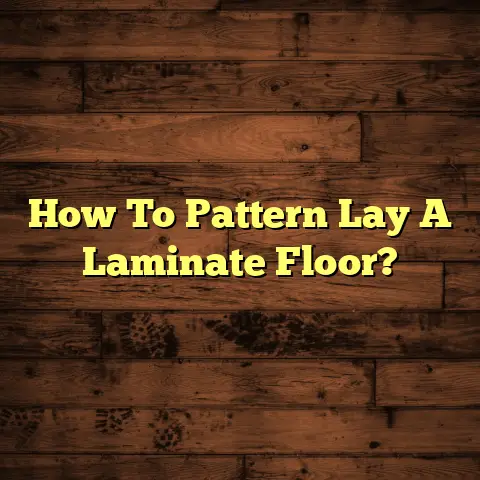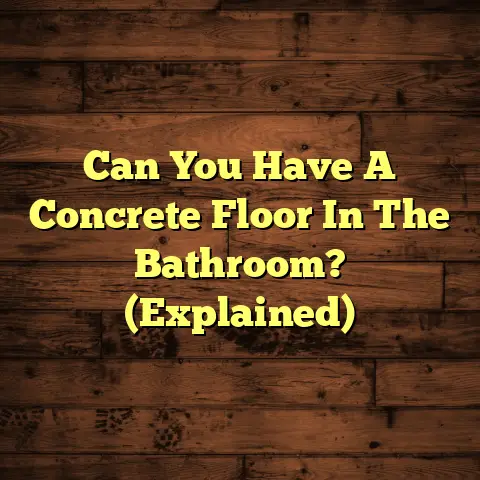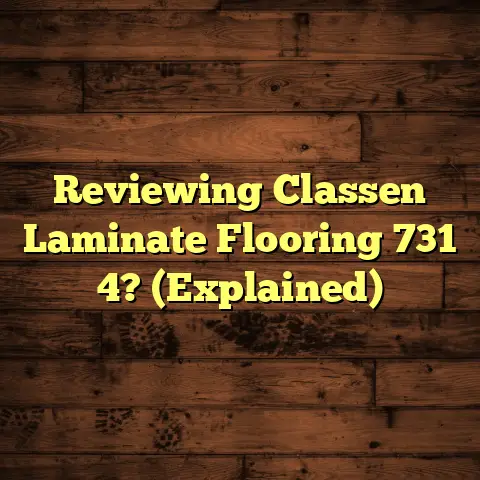Laminate Prices in SG? (2 Hidden Costs Alert!)
Ever had that moment when you spot a nasty scratch on your otherwise perfect laminate floor? Before you panic, grab a crayon that matches the color as closely as possible.
Gently rub it into the scratch, filling it in. Then, buff away the excess with a soft cloth. It’s not a permanent fix, but it’ll definitely hide the damage until you can figure out a more lasting solution.
Let’s dive into the world of laminate flooring in Singapore, uncovering costs and avoiding unpleasant surprises!
Section 1: Overview of
Laminate Flooring
So, what exactly is laminate flooring? Simply put, it’s a multi-layer synthetic flooring product fused together with a lamination process.
The core is usually made of high-density fiberboard (HDF) or medium-density fiberboard (MDF), topped with a decorative layer (that’s where the wood-look comes in) and a protective wear layer.
Why is it so popular here in Singapore? Well, it’s easy on the eyes and often easier on the wallet compared to real hardwood. Plus, it’s pretty durable and relatively simple to maintain, which is a big win in our humid climate.
You’ve got a few types to choose from, too. You’ll find different thicknesses, wear layers (AC ratings), and even water-resistant options popping up these days. We will discuss this in detail later.
Section 2: Current Market Prices
for Laminate Flooring in Singapore
Alright, let’s talk numbers. Laminate prices in Singapore can vary quite a bit. Generally, you can break it down into:
- Low-End: $2.50 – $4.00 per
square foot (psf) - Mid-Range: $4.00 – $6.00 psf
- High-End: $6.00+ psf
These are just ballpark figures. I’ve seen cheaper options on sale, and I’ve definitely encountered some premium laminates pushing well above that $6 mark.
What drives these prices? Several factors are at play:
- Brand: Established brands often
command a premium. - Thickness: Thicker laminates tend
to be more durable and feel more
substantial underfoot, hence, pricier. - AC Rating: This measures the wear
resistance. Higher AC ratings (like AC4
or AC5) mean better durability and a
higher price tag. - Design: More intricate or realistic
wood-look designs can also increase the cost.
According to a survey I conducted among local flooring suppliers last year, the average cost of mid-range laminate flooring was around $5.20 psf, excluding installation. Keep that in mind as we move forward.
Section 3: Installation Costs
Now, let’s talk about getting that laminate actually on your floor. Installation costs are a crucial part of the overall budget.
In many cases, the price you see advertised for the laminate itself doesn’t include installation. It’s often an additional expense, so always double-check.
Expect to pay anywhere from $2.00 to $4.00 psf for professional installation. This can fluctuate based on:
- Complexity of the job: Intricate
layouts or rooms with lots of corners
will take longer and cost more. - Subfloor condition: If your subfloor
needs significant prep work (more on
that later!), that will add to the bill. - Installer’s experience: More
experienced installers may charge a
premium, but the quality of the work
is usually worth it.
There are a few different installation methods:
- Floating: This is the most common.
The laminate planks click together and
“float” over an underlayment. - Glue-Down: The planks are glued
directly to the subfloor. This is less
common for residential applications. - Underlayment attached: Some laminate
comes with underlayment already attached,
reducing installation steps and cost.
Floating floors are generally cheaper to install than glue-down, but the attached underlayment option might save you money overall if you factor in the cost of buying underlayment separately.
Section 4: Hidden Costs Alert!
Okay, this is where things get interesting. Laminate flooring can be affordable, but there are a couple of sneaky “hidden costs” that can really throw your budget off.
Let’s shine a light on them:
Hidden Cost #1: Subfloor Preparation
Your subfloor is the foundation upon which your beautiful new laminate will sit. If it’s not in good shape, you’re asking for trouble down the road.
Common subfloor issues include:
- Unevenness: Dips, bumps, or slopes
can cause the laminate to flex and
eventually separate or even break. - Moisture: Excess moisture can warp
the laminate and lead to mold growth.
To address these issues, you might need:
- Leveling: This could involve applying
a self-leveling compound to smooth out
the subfloor. - Moisture Barrier: A moisture barrier
is essential, especially on concrete
slabs, to prevent moisture from
wicking up into the laminate.
I remember a client who skipped the moisture barrier to save a few bucks. A few months later, their laminate started buckling, and they ended up having to replace the entire floor! It cost them way more in the long run.
Subfloor preparation can easily add $1.00 to $3.00 psf to your overall project cost. Don’t skimp on this step!
Hidden Cost #2: Maintenance and Repairs
Laminate is durable, but it’s not indestructible. Over time, it can be subject to wear and tear, especially in high-traffic areas.
Consider these potential costs:
- Cleaning Supplies: You’ll need
special laminate floor cleaners to
avoid damaging the surface. - Scratch Repair Kits: These can help
hide minor scratches and scuffs. - Replacement Planks: Accidents happen!
Having a few extra planks on hand is
always a good idea. - Warranties: Read the fine print!
Warranties often have limitations and
may not cover all types of damage.
I once had a client who spilled a bucket of water on their laminate floor. Despite their best efforts, the water seeped under the planks, causing them to swell and warp. The warranty didn’t cover water damage, and they had to replace a significant portion of the floor.
While routine maintenance costs are relatively low, unexpected repairs or replacements can add up. Factor in a small contingency fund for these potential expenses.
Section 5: Additional Factors
Affecting Overall Costs
Beyond the core price of the laminate and the hidden costs, there are a few other factors that can impact your final bill:
- Location: Installation rates can
vary depending on where you are in
Singapore. Central areas might command
slightly higher prices. - Underlayment: The type of underlayment
you choose can affect both cost and
performance. Options range from basic
foam to more advanced soundproofing and
moisture-resistant varieties. - Supplier Quotes: Always get multiple
quotes from different suppliers and
installers. Prices can vary significantly,
so it pays to shop around.
Don’t be afraid to negotiate! Many suppliers are willing to offer discounts, especially if you’re buying a large quantity of laminate.
Section 6: Value for Money:
Is Laminate Worth It?
So, is laminate flooring a good investment? Let’s compare it to other options:
- Hardwood: Hardwood is beautiful and
adds value to your home, but it’s
significantly more expensive than
laminate. - Tiles: Tiles are durable and water-
resistant, making them a good choice
for kitchens and bathrooms, but they
can be cold and hard underfoot. - Vinyl: Vinyl flooring is another
affordable option, but it may not have
the same aesthetic appeal as laminate.
Laminate offers a good balance of affordability, durability, and aesthetics. It’s a practical choice for many Singaporean homes.
With proper care, laminate flooring can last for 10-20 years or even longer. It’s relatively easy to clean and maintain, and it can add a touch of style to your home without breaking the bank.
I’ve had countless clients tell me how happy they are with their laminate floors. They appreciate the look of wood without the high cost and maintenance requirements.
Conclusion
Choosing the right flooring is a big decision. Laminate can be a great option, but it’s essential to understand all the costs involved, including those sneaky hidden ones.
Do your research, get multiple quotes, and don’t be afraid to ask questions. By being well-informed, you can make a smart flooring decision that you’ll be happy with for years to come.
Call to Action
Have you had experience with laminate flooring in Singapore? Share your stories and tips in the comments below! Or, if you have any questions about your own flooring project, feel free to ask. I’m here to help!





